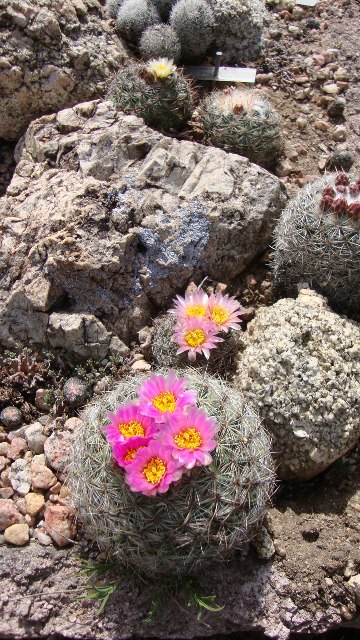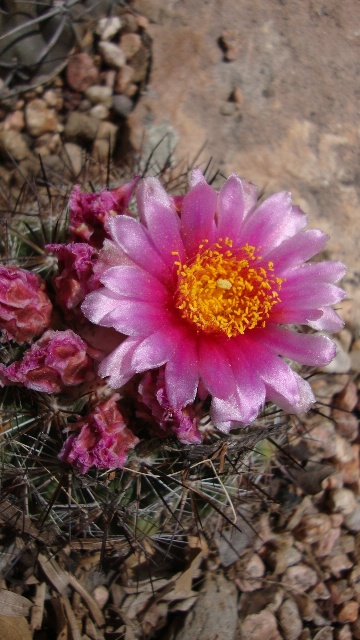I posted some pix elsewhere of this great group that is so incredibly abundant and variable in much of the West. Two more pix: the first is of the common form just west of Denver (much of it, alas, destroyed by housing) we call the snowball. There are white spined pedios elswhere in the West. I have a wonderful pale pink one from Monarch Pass, and I saw wonderful white spined pedios from Wyoming grown by Bob Johnson in Utah. But the soft pink flowers of our local frorm are the best in my opinion. Alas, it crosses much too easily!
The second picture is of var. robustior from the Pacific Northwest, a very different creature. Apparently, this clumps up in nature (our local forms rarely do) and has much larger, darker flowers. Very cool! Hope I can keep it going...



Comments
John P. Weiser
Re: Pediocactus: the Mountain Ball cacti
Wed, 05/12/2010 - 2:48pmPK
Great shots of one of the more unusual alpines.
Pediocactus do well where winters are cold and damp, but not so well where summer nights are hot and humid. They prefer cool summer nights with low humidity, just like most alpines.
There are between six - nine species depending upon the source you are reading. Flora of North America lists nine, whereas USDA Plants Data Base lists seven. (just to name two). The varieties within the species is also in contention. Very confusing indeed.
Two things are apparent when trying to purchase specimens. The first is that the most readily available for purchase is Pediocactus simpsonii and it's varieties due to it's wide spread distribution across the mountain ranges of Western North America. The other issue has to due with the limited distribution of the other species.
Seven of which are rare plants native to the Colorado Plateau region of Utah, Colorado, New Mexico, and Arizona. This fact brings them under the CITES rules governing sales and re-importaion of endangered species.
It is frustrating that specimens can be found for sale in Canada and European nurseries but not available state side.
I grow two forms of P. simpsonii. One very similar to your first photo. The other is a taller version of the first.
BalistrieriCarlo (not verified)
Re: Pediocactus: the Mountain Ball cacti
Wed, 05/12/2010 - 2:59pmWeiser et al,
The entire Cactaceae family is listed on the CITES appendices, not just the Pediocactus you are referring to. BUT CITES regulates ONLY international trade--not trade within the United States or another country. In addition, it is often thought that CITES prohibits trade, but in fact most species of cacti are listed on Appendix II and may be legally traded internationally as long as the appropriate paperwork is obtained.
Be aware that there may be national laws that apply.
John P. Weiser
Re: Pediocactus: the Mountain Ball cacti
Wed, 05/12/2010 - 6:27pmCarlo
You are no doubt correct about the CITES regulations and I would think the United States Endangered Species Act, plays a larger roll in restricting sales to the U.S.
I was in anycase, disappointed that I could not re-import nursery propagated plants into the U.S.
That's water over the bridge though, since there are still plenty of new species to try! ;D
Panayoti Kelaidis
Re: Pediocactus: the Mountain Ball cacti
Wed, 05/12/2010 - 9:31pmJust downloaded another batch of pictures and found some more Pedios I'd like to post: the first is my biggest plant, grown from seed from the Uinta basin. It is the nearest approach I have to yellow. The second picture is of plants grown from seed from nearly 10,000' on Monarch Pass in south central Colorado.
Sure love these plants!
BalistrieriCarlo (not verified)
Re: Pediocactus: the Mountain Ball cacti
Thu, 05/13/2010 - 5:45amLOVE the dusty pink. Beautiful!
John P. Weiser
Re: Pediocactus: the Mountain Ball cacti
Thu, 05/13/2010 - 6:03amPK
Very nice collection! They look like they enjoy your attention. ;)
cohan (not verified)
Re: Pediocactus: the Mountain Ball cacti
Sat, 02/19/2011 - 8:31pmPedios are my favourite group of hardy cacti, and I have high hopes for them here, but only a couple of tiny seedlings so far...lol
As for CITES, I forget the categories, probably the various Appendices as Carlo mentions, but all Pedios are not listed the same--eg, Mesa gardens will supply seed of numerous forms of P simpsonii, as will Alplains, without need for a CITES permit, but most other species are more restricted and require the paperwork/fees.
Sometimes, can't be exported means the vendor is not set up to supply that paperwork!
I'm encouraged to note that a grower in B.C zone 3 is growing P nigrispinus (or P simpsonii v nigrispinus) very successfully, in spite of it being rated zone 5 by many sources (many simpsonii are z 3) it is a larger plant, darker spines, though many forms again....